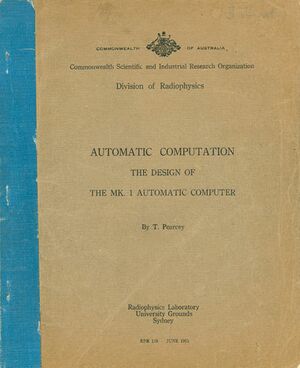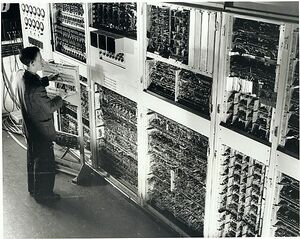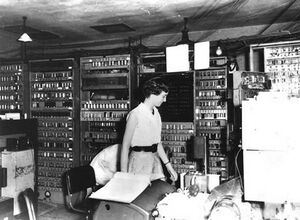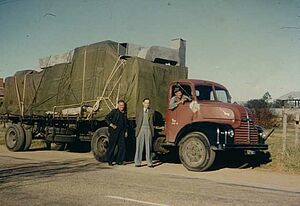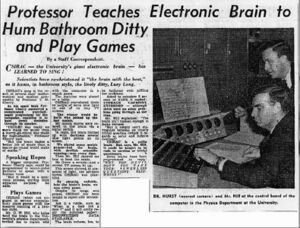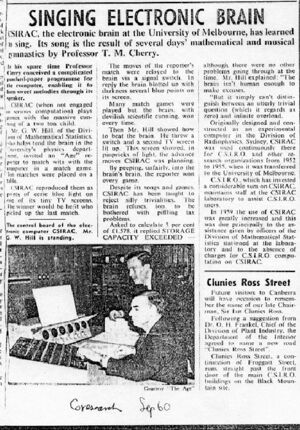CSIRAC: Difference between revisions
mNo edit summary |
mNo edit summary |
||
| (3 intermediate revisions by the same user not shown) | |||
| Line 30: | Line 30: | ||
Although there may be a direct line that somehow ties the Australian experience with what would be realized in England, there is also an important difference in that time plays in favor of the CSIR Mk1. The latter, in fact, was equipped with an audio circuit programmable, which allowed to generate sounds not only fixed but also of variable frequencies, an essential aspect in order to perform real melodies rather than simple continuous sounds, which is would be limited to the Manchester Mark I and the EDSAC, if they were used for musical purposes. | Although there may be a direct line that somehow ties the Australian experience with what would be realized in England, there is also an important difference in that time plays in favor of the CSIR Mk1. The latter, in fact, was equipped with an audio circuit programmable, which allowed to generate sounds not only fixed but also of variable frequencies, an essential aspect in order to perform real melodies rather than simple continuous sounds, which is would be limited to the Manchester Mark I and the EDSAC, if they were used for musical purposes. | ||
The computer EDSAC University of Cambridge, in an image taken in May of 1949. | [[File:The-Edsac-computer.jpg|thumb|alt=The computer EDSAC University of Cambridge, in an image taken in May of 1949.|The computer EDSAC University of Cambridge, in an image taken in May of 1949.]] | ||
The first computer in the United Kingdom, also to be equipped with a variable frequency circuit, was the Ferranti Mark I, a commercial version of the Manchester Mark I, on which – not surprisingly – we would have to tell a story as interesting as that of the CSIRAC. It is likely that in this story I will dedicate myself in the coming weeks, for the moment I will only point out that the Ferranti Mark I was programmed to generate sounds in September 1951, with a delay of a few weeks than the Australian experimentation. | The first computer in the United Kingdom, also to be equipped with a variable frequency circuit, was the Ferranti Mark I, a commercial version of the Manchester Mark I, on which – not surprisingly – we would have to tell a story as interesting as that of the CSIRAC. It is likely that in this story I will dedicate myself in the coming weeks, for the moment I will only point out that the Ferranti Mark I was programmed to generate sounds in September 1951, with a delay of a few weeks than the Australian experimentation. | ||
| Line 49: | Line 49: | ||
Acting on the console of the computer, the operator could select which melody run. But in what way the researchers were able to generate sounds? The technique used, as I mentioned earlier, it was rather primitive: the frequency of the sounds was defined by cycles of pulses sent directly to the speakers, and through a programming job was possible to get a wave with a sawtooth profile. Acting on the pulse was also possible to define the amplitude, and each operation was carried out in real time as the CSIRAC was not equipped with any storage device. | Acting on the console of the computer, the operator could select which melody run. But in what way the researchers were able to generate sounds? The technique used, as I mentioned earlier, it was rather primitive: the frequency of the sounds was defined by cycles of pulses sent directly to the speakers, and through a programming job was possible to get a wave with a sawtooth profile. Acting on the pulse was also possible to define the amplitude, and each operation was carried out in real time as the CSIRAC was not equipped with any storage device. | ||
The adoption of a technique so little refined was motivated by necessity rather than by a real choice. In fact, in Australia, in that historical moment, was not yet available as a basic tool of the digital signals to analog converter. It is worth mentioning here that the great difference between the experiments conducted by Max Mathwes at Bell Labs with Music N and those made elsewhere, and also in Australia, lies in the possibility to take advantage of that technology. | |||
[[File:The-csirac-computer-moved-to-melbourne.jpg|thumb|left|alt=An image showing the removal of the CSIRAC from Sydney to Melbourne. June 1955. Via www.csse.unimelb.edu.au|An image showing the removal of the CSIRAC from Sydney to Melbourne. June 1955. Via www.csse.unimelb.edu.au]] | |||
The | |||
Music… in Melbourne – The permanence of the CSIR Mk1 in Sydney lasted until June 1955. At that point it was decided that the Australian super computer would continue to render his services for the Department of Physics of the University of Melbourne, where exactly was moved and where remained in operation until 1964. the installation in the new residence earned the CSIR Mk1 also a change of name, thus assuming the more well known name CSIRAC. | Music… in Melbourne – The permanence of the CSIR Mk1 in Sydney lasted until June 1955. At that point it was decided that the Australian super computer would continue to render his services for the Department of Physics of the University of Melbourne, where exactly was moved and where remained in operation until 1964. the installation in the new residence earned the CSIR Mk1 also a change of name, thus assuming the more well known name CSIRAC. | ||
The new life of Melbourne is characterized not only by the name change, but also for a renewed push to the musical project of CSIRAC. The most important contribution, alongside that of Geoff Hill who continued to take an interest in the fate of the music, came from Thomas Cherry, Professor of Mathematics. The first objective place, and reached by Cherry was to increase the dynamic range of tones, by making some modifications in the programming phase. | The new life of Melbourne is characterized not only by the name change, but also for a renewed push to the musical project of CSIRAC. The most important contribution, alongside that of Geoff Hill who continued to take an interest in the fate of the music, came from Thomas Cherry, Professor of Mathematics. The first objective place, and reached by Cherry was to increase the dynamic range of tones, by making some modifications in the programming phase. | ||
One of the first songs heard in Melbourne was Gaudeaums Igitur, programmed in collaboration with Geoff Hill and performed on the occasion of the public presentation of CSIRAC in 1956. The experimentation of Melbourne is summed up in a couple of tests of musical scales and data programming of two melodies, So early in the Morning and In Cellar Cool. Added to this is another song, performed in 1958: Lucy Long, a theme with variations for bassoon. The choice of the latter was motivated by Cherry that in his opinion the sounds made with the CSIRAC remembered precisely those of a bassoon. | One of the first songs heard in Melbourne was Gaudeaums Igitur, programmed in collaboration with Geoff Hill and performed on the occasion of the public presentation of CSIRAC in 1956. The experimentation of Melbourne is summed up in a couple of tests of musical scales and data programming of two melodies, So early in the Morning and In Cellar Cool. Added to this is another song, performed in 1958: Lucy Long, a theme with variations for bassoon. The choice of the latter was motivated by Cherry that in his opinion the sounds made with the CSIRAC remembered precisely those of a bassoon. | ||
| Line 87: | Line 82: | ||
The Australian newspaper The Age devoted an article to the music composed by CSIRAC, 1960. | The Australian newspaper The Age devoted an article to the music composed by CSIRAC, 1960. | ||
[[File:The-age-newspaper-and-the-music-of-csirac1.jpg|thumb|left|alt=The Australian newspaper The Age devoted an article to the music composed by CSIRAC, 1960.|The Australian newspaper The Age devoted an article to the music composed by CSIRAC, 1960.]] | |||
The project involved Ron Bowles, John Spencer and Jurij Semkiw, who were asked to create a personal computer with an emulator of CSIRAC. Programming tracks was derived from the original punch cards. For the definitive record of the music was even reused the old system of spreading the CSIRAC, meanwhile hosted by Museum Victoria. The greatest satisfaction of Paul Doornbusch, as he wrote, was the opinion of those who were able to listen to original music, and who considered new registrations quite similar to the original. | The project involved Ron Bowles, John Spencer and Jurij Semkiw, who were asked to create a personal computer with an emulator of CSIRAC. Programming tracks was derived from the original punch cards. For the definitive record of the music was even reused the old system of spreading the CSIRAC, meanwhile hosted by Museum Victoria. The greatest satisfaction of Paul Doornbusch, as he wrote, was the opinion of those who were able to listen to original music, and who considered new registrations quite similar to the original. | ||
[[File:The-newspaper-about-the-music-of-the-csirac.jpg|thumb|alt=The Australian newspaper The Age devoted an article to the music composed by CSIRAC, 1960.|The Australian newspaper The Age devoted an article to the music composed by CSIRAC, 1960.]] | |||
The newspapers are interested in the experiment musical CSIRAC, 1960. | The newspapers are interested in the experiment musical CSIRAC, 1960. | ||
| Line 95: | Line 94: | ||
Another newspaper interested to the music of CSIRAC. | Another newspaper interested to the music of CSIRAC. | ||
In the book of Paul Doornbusch also includes a CD that contains all the music made with the CSIRAC, however the net you can find some examples enough to get an idea of what results had been achieved in Australia in that historical period. To listen to Colonel Bogey, the first song made with the Australian computer click this link, while at this link you can listen to the second version of In Cellar Cool, that they are also simulated all the noise that normally could be heard along with the musical part during executions original fifties. | In the book of Paul Doornbusch also includes a CD that contains all the music made with the CSIRAC, however the net you can find some examples enough to get an idea of what results had been achieved in Australia in that historical period. To listen to Colonel Bogey, the first song made with the Australian computer click this link, while at this link you can listen to the second version of In Cellar Cool, that they are also simulated all the noise that normally could be heard along with the musical part during executions original fifties. | ||
Latest revision as of 20:45, 28 August 2021
The facts of some pioneering experiences of computer music that took place in the United States, more or less in the same years of CSIRAC. From this point of view, the Australian experiment complet the path that I presented in October 2014 at the Conservatorio di Santa Cecilia in Rome on the occasion of the 20th Colloquium on Music Informatics.
CSIR Mk1 or CSIRAC?(pronounced sigh-rack).
Commonly the Australian research is remembered for being carried out with a CSIRAC, so much so that even the book by Paul Doornbusch (composer and computer scientist who first told this story) is titled The Music of Csirac. However, the CSIRAC, whose story unfolds in two stages between Sydney and Melbourne, was initially called CSIR Mk1 (the initials of CSIR stood for Council for Scientific and Industrial Research, commonly was referred to it simply as machine Mk1), the first Australian digital computer and the fifth in the world history. The name was changed to CSIRAC (Council for Scientific and Industrial Research Automatic Computer) after transferring from Sydney to Melbourne.
The CSIR Mk1 was designed and built in Sydney in 1949 by Trevor Pearcey and Maston Beard, on the initiative of the Committee for Scientific and Industrial Research. It was a mainframe computer of considerable size, with a computing power absolutely ridiculous when compared with current computers. Just think that the first software of CSIR MK1, designed by Geoff Hill in November of the same year, turned it into a simple but cumbersome calculator capable of multiplying two numbers at a time.
The Australian computer was a serial computer, very slow, capable of transmitting 1 bit at a time, so to speak, the machines of today are able to transmit 32 or 64 in parallel, that is, at the same time. The transfer of the data took place between a source of origin and a destination, which could consist in a memory allocation or, as in the case of the experiment of music, in a loudspeaker.
Audio – The technical feature more interesting, given the subject of this site, was the presence of a speaker. The fact that the CSIR MK1 was equipped with a device of this kind was not a big news, since also others computer in circulation in those years had a pretty common thing. Usually these machines were equipped with a small programmable circuit – or not .- which allowed the generation of sounds very rough.
What was the function of this small audio system? For the most alert the user of the progress of certain actions: for example, the presence of errors in the programming code or the completion of a routine, whose signaling was through the generation of a sound signal. To return to a comparison with what is happening today, I think it is fair to say that those signals were similar to the beeps emitted by the bios powering any computer desktop.
Ferranti Mark I – As I wrote earlier, the CSIR Mk1 was not the only machine in those years, to be equipped with a loudspeaker. Among other calculators we also have the Manchester Mark I, operational since June 1948, and the EDSAC of the University of Cambridge, in operation since May of next year. Of these calculators also speaks Paul Doornbusch, because around those rotate the question of what was the first computer to play music. Why the stories of these two computers English are so great? Because the first documents that describe the speaker installed on CSIR Mk1 are dated 1950 and since Trevor Pearcey, who was the designer, before completing the CSIR Mk1, was able to see the two computers during a stay in England, it is likely that he was inspired by those machines for the implementation of a speaker on CSIR Mk1.
It is clear that the issue is not focused on those who, for one, has welcomed a sound system generation, the point is to understand who has the record of having heard some digital stirrings, given that in a few weeks are documented two different experiences.
Although there may be a direct line that somehow ties the Australian experience with what would be realized in England, there is also an important difference in that time plays in favor of the CSIR Mk1. The latter, in fact, was equipped with an audio circuit programmable, which allowed to generate sounds not only fixed but also of variable frequencies, an essential aspect in order to perform real melodies rather than simple continuous sounds, which is would be limited to the Manchester Mark I and the EDSAC, if they were used for musical purposes.
The first computer in the United Kingdom, also to be equipped with a variable frequency circuit, was the Ferranti Mark I, a commercial version of the Manchester Mark I, on which – not surprisingly – we would have to tell a story as interesting as that of the CSIRAC. It is likely that in this story I will dedicate myself in the coming weeks, for the moment I will only point out that the Ferranti Mark I was programmed to generate sounds in September 1951, with a delay of a few weeks than the Australian experimentation.
August 1951 – According to research conducted by Paul Doornbusch, different data lead to think that the CSIR Mk1 would issue the first sounds already in 1950, but the official date, very specific, seems to be that of 6/7 August 1951, at the first australian Conference of Automatic Computing Machines.
Music… in Sidney – At the beginning of this article I wrote that the story of the CSIR Mk1 experienced two distinct phases: the first, as evidenced by the title of this section, is in Sidney, between late 1949 and mid 1955. During this period of time, Geoff Hill was seized of musical experimentation.
He took charge of programming the computer CSIR Mk1 in order to get him to perform a series of very popular melodies for the era: Colonel Bogey, Bonnie Banks, Girl with Flaxen Hair, Auld Lang Syne, a march by Chopin, Thanks for the Memory, air Saul from the Messiah by Handel and other variations based thereon. To these songs is also added Greensleeves, unfortunately the only, as writes Doornbusch, of which there is no document received [Doornbusch, Paul].
For everyone else it was possible to prepare a work of reconstruction of sound, from the data of programming content in punched cards.
…anecdotal evidence suggests that Colonel Bogey was chosen because it was such a popular favourite and Trevor Pearcey was aware of the need to make a positive impression at the public unveiling of the CSIR Mk1 in 1951.
Acting on the console of the computer, the operator could select which melody run. But in what way the researchers were able to generate sounds? The technique used, as I mentioned earlier, it was rather primitive: the frequency of the sounds was defined by cycles of pulses sent directly to the speakers, and through a programming job was possible to get a wave with a sawtooth profile. Acting on the pulse was also possible to define the amplitude, and each operation was carried out in real time as the CSIRAC was not equipped with any storage device.
The adoption of a technique so little refined was motivated by necessity rather than by a real choice. In fact, in Australia, in that historical moment, was not yet available as a basic tool of the digital signals to analog converter. It is worth mentioning here that the great difference between the experiments conducted by Max Mathwes at Bell Labs with Music N and those made elsewhere, and also in Australia, lies in the possibility to take advantage of that technology.
Music… in Melbourne – The permanence of the CSIR Mk1 in Sydney lasted until June 1955. At that point it was decided that the Australian super computer would continue to render his services for the Department of Physics of the University of Melbourne, where exactly was moved and where remained in operation until 1964. the installation in the new residence earned the CSIR Mk1 also a change of name, thus assuming the more well known name CSIRAC.
The new life of Melbourne is characterized not only by the name change, but also for a renewed push to the musical project of CSIRAC. The most important contribution, alongside that of Geoff Hill who continued to take an interest in the fate of the music, came from Thomas Cherry, Professor of Mathematics. The first objective place, and reached by Cherry was to increase the dynamic range of tones, by making some modifications in the programming phase.
One of the first songs heard in Melbourne was Gaudeaums Igitur, programmed in collaboration with Geoff Hill and performed on the occasion of the public presentation of CSIRAC in 1956. The experimentation of Melbourne is summed up in a couple of tests of musical scales and data programming of two melodies, So early in the Morning and In Cellar Cool. Added to this is another song, performed in 1958: Lucy Long, a theme with variations for bassoon. The choice of the latter was motivated by Cherry that in his opinion the sounds made with the CSIRAC remembered precisely those of a bassoon.
The work done in Melbourne by Thomas Cherry did not end in the realization of these few songs but also enriched the completion of the Music Programme, a music software that allowed to interact with the CSIRAC making use of the common notions of traditional notation.
And Max Mathews? – If we take into account that the Music Programme was developed in about 1957, that is, in the same year in which he was officially developed the Music I by Max Mathews, we understand that the Australian research threatens to undermine not only the problem on the first computer used for generate sounds but also the idea that the first music software was actually made in the United States, at Bell Labs.
It is clear that the issue may be relevant only on a purely chronological, because from a technological point of view, that is examining the potential of the Music Programme with those of which was equipped with the Music I, the comparison was non-existent. Max Mathews and staff of Bell Labs benefited from an availability of technology far more advanced than that of Australian colleagues, who were also suffering from a condition of heavy cultural isolation, responsibility for which was in the peripheral geographical location. Moreover there is no denying that the demonstration of this isolation derives the history of CSIRAC, which for a long time was largely unknown even to those directly involved in this digital revolution of music.
It can be argued that the isolation of Australia is back for the benefit of research by Max Mathews, widely considered the father of computer music? No, it is not only an issue of timing. What distinguishes the work of Max Mathews, and which earned him the title of pioneer of computer music, you can find many reasons, among which are to mention at least two: the continuity of the research, which lasted well beyond the fifties and arrived until his last years of life if we take into account the intended work of spreading, and the quality of the musical results achieved through the sharing of their work with a number of professional composers.
The picture shows the computer CSIRAC after the restoration project of the nineties, before it was finally deposited in the Museum of Melbourne where she was shooting this photo.
Play it again, CSIRAC! – Although the results achieved in Australia does not have tarnished the genius of Max Mathews, the fact remains that the historical investigation of Paul Doornbusch on musical experiments with CSIRAC is a work of great interest; which has the merit of having made more complete historical overview of pioneering in digital music.
Added to this is that Doornbusch not merely pick up the pieces of a story, told in his book The Music of CSIRAC, but thought even resurrect the music made in those years in Australia, promoting a recovery project whose purpose was to listen to the music generated with CSIRAC between the fifties and sixties.
I had not specified that in those years no one had the idea to record on some magnetic media music composed with CSIRAC. When Doornbusch became interested in the history of CSIRAC, there was no evidence of musical experiments conducted in Australia. Fortunately they had saved from oblivion punch cards, containing the data of the programming of all the songs that I mentioned in this article.
It was not possible to patch up the old computer, but with the documents available was conceivable to set up a machine that emulates the CSIRAC, in order to obtain a result that was similar as possible to the original one.
The Australian newspaper The Age devoted an article to the music composed by CSIRAC, 1960.
The project involved Ron Bowles, John Spencer and Jurij Semkiw, who were asked to create a personal computer with an emulator of CSIRAC. Programming tracks was derived from the original punch cards. For the definitive record of the music was even reused the old system of spreading the CSIRAC, meanwhile hosted by Museum Victoria. The greatest satisfaction of Paul Doornbusch, as he wrote, was the opinion of those who were able to listen to original music, and who considered new registrations quite similar to the original.
The newspapers are interested in the experiment musical CSIRAC, 1960.
Another newspaper interested to the music of CSIRAC.
In the book of Paul Doornbusch also includes a CD that contains all the music made with the CSIRAC, however the net you can find some examples enough to get an idea of what results had been achieved in Australia in that historical period. To listen to Colonel Bogey, the first song made with the Australian computer click this link, while at this link you can listen to the second version of In Cellar Cool, that they are also simulated all the noise that normally could be heard along with the musical part during executions original fifties.
The Adventure of CSIRAC, as innovative and interesting, was short-lived as I wrote. In the same fifties, and as early as the last year Quaranta, elsewhere, mainly in the US, other atività experimental recording around the possible applications of computer music. For example I could mention the story of Push Button Bertha, or better known Illiac Suite, and many others which I will write soon.
References
Doornbusch, Paul; Computer Sound Synthesis in 1951: The Music of CSIRAC, Computer Music Journal, Vol. 28 [1], 2004, pp. 10 – 25.
Doornbusch, Paul; The Music of Csirac: Australia’s First Computer Music, Common Ground Publishing, 2005.
Web
